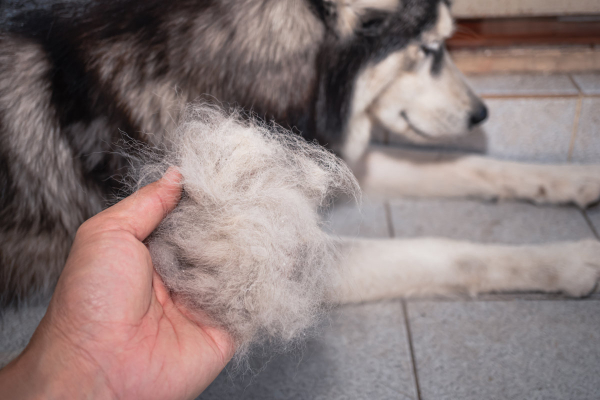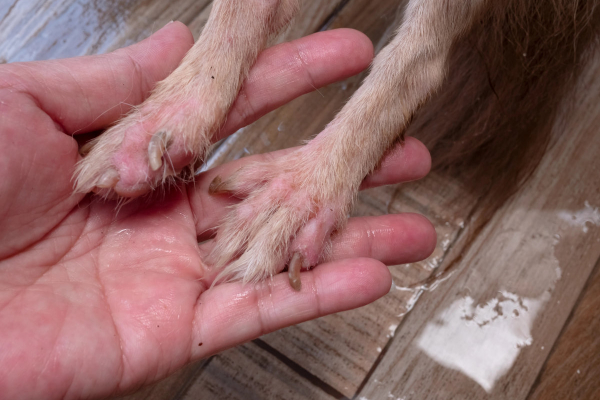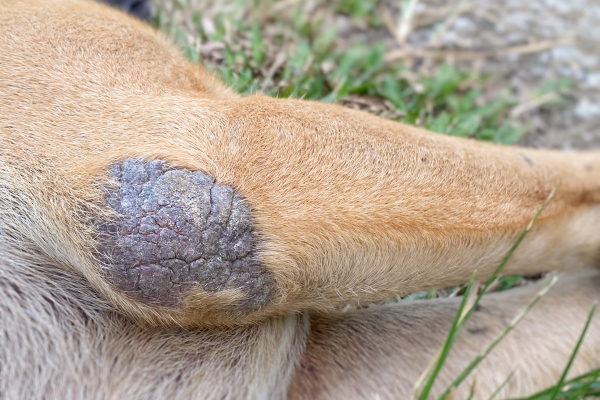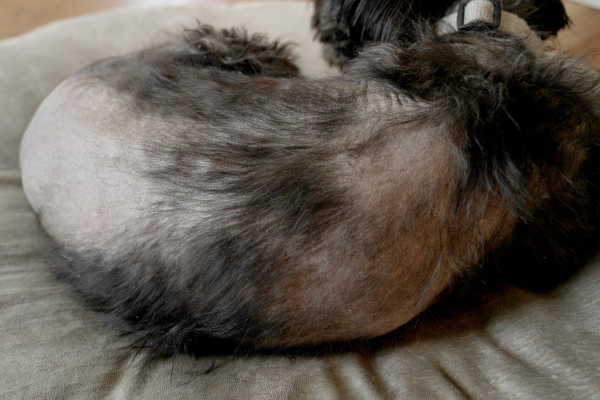Why is my dog losing hair? If you find yourself asking that question, ultimately the answer will come from your veterinarian. However, to help you understand the potential conditions that cause hair loss, integrative veterinarian Dr. Julie Buzby discusses 10 reasons why your dog is losing hair.

When a dog has a problem with his or her internal organs, bones, or muscles, it isn’t always obvious at first. However, if your dog is losing hair, that is usually pretty easy to notice. You may see bare patches on your dog’s body. Or you might suddenly have hair tumbleweeds rolling down the hallway and dog hair sticking to every surface.
At that point, the question becomes, “Is this normal hair loss or do I need to take my dog to the vet?” That’s exactly what I hope to help you understand.
What constitutes hair loss in dogs?
Hair loss in dogs can look different in each situation and for each dog. Some dogs simply have increased shedding compared to normal, or they shed excessively during abnormal times of year. Other dogs will develop small bald patches or areas of thinner hair, but the rest of the fur coat looks normal and healthy. And some dogs experience severe hair loss over much of their body.
Also, sometimes hair loss is the only symptom you see. But in other situations, the dog’s skin might look abnormal, or the dog may be showing systemic symptoms like weight loss or changes in thirst and urination. All of these details are important to note so that you can best help your vet get to the bottom of why your dog is losing hair.
When is it normal for a dog to be losing hair?
Seasonal shedding is normal, and it is the most common reason for a dog to be losing hair. Even if your dog sheds all year round, he or she may experience periods of extreme shedding when seasons change. This is especially common in the spring as the weather warms up and your dog no longer needs a thick winter coat.
Seasonal shedding happens all over your dog’s body. Especially in thicker coated breeds, the hair can even be lost in large clumps or tufts. However, the dog shouldn’t develop any bald patches or areas of thin hair due to seasonal shedding. And the skin itself should be normal (not red, dry, irritated, or itchy).

If the skin looks abnormal, the dog is going bald in places, or you are noticing other symptoms, the culprit probably isn’t just seasonal shedding. It may be one of the 10 abnormal conditions below.
10 reasons a dog is losing hair
There are many potential reasons for hair loss in dogs. However, these 10 conditions tend to be the most common.
1. Allergies
Allergies are one of the most common abnormal reasons for dogs to lose hair. Some dogs develop an allergy to an ingredient in their food, usually the protein source. Other dogs may have environmental allergies (atopic dermatitis) and be allergic to pollens, dust or dust mites, or other irritants in the environment. Finally, dogs with flea allergic dermatitis (FAD) are allergic to flea saliva. A dog may have one or more of these types of allergies.
Dogs with allergies can experience various levels of hair loss, ranging from increased shedding to bald patches or almost complete hair loss. The location of the hair loss can correspond to the type of allergy.
For example, dogs with food or environmental allergies tend to experience itchy skin and hair loss around their feet or legs, face, and underside of the belly. However, dogs with FAD may have more hair loss at the base of the tail and down the back legs.
In addition to the hair loss, dogs with allergies may have the following symptoms:
- Red, irritated skin
- Scabs, crusts, or pustules on the surface of the skin
- Skin that is warm or sensitive to the touch
- Excessive scratching
- Chewing at itchy dog paws or other areas of the body
- Dry, flaky skin
- Ear infections (otitis in dogs)
- Increased discharge from the eyes or nose
- Vomiting or diarrhea (with food allergies)
- Thickened black skin (a sign of chronic skin inflammation)
If you notice hair loss and some of the symptoms above, please consult your vet. Allergies can’t be cured, but there are many ways to manage them, including allergy medicine for dogs.

2. Yeast and bacterial skin infections
Dogs also frequently lose hair due to skin infections. Most of the time, these infections occur because another skin condition such as allergies or fleas causes the dog to traumatize the skin. This breaks down the skin barrier, allowing a bacterial infection (pyoderma in dogs) or yeast infection to take hold.
Skin infections can develop on any part of your dog’s body. Depending on the infection and cause, hair loss can occur in patches, clumps, only one spot, a large location, or across your dog’s whole body. Additionally, the dog may have red, irritated skin that is crusty, flaky, or has reddish bumps on it. Since the dog is often itchy, you may notice excessive scratching or licking, especially in the areas of hair loss.
The veterinarian may perform a skin cytology to diagnose a skin infection. Then he or she will develop a treatment plan, which usually involves topical and/or systemic antibiotics or antifungals plus addressing allergies (or whatever broke down the skin barrier.)
3. Fleas
After allergies and skin infections, parasites like fleas are the next problem to consider in dogs who are losing hair. This is especially true if a dog is itching or losing hair during warm months and he or she is not currently on a veterinarian-prescribed flea preventive.
Fleas can be found all over the country in many different climates (and so can ticks, another parasite capable of causing hair loss). If your dog goes outside, especially to a dog park, hiking, or an place other animals visit, your dog could get fleas. However, you can also bring fleas into the house on your clothing, and other pets can bring them in too. So even if your dog rarely sets paw on the ground outside, fleas could still be the culprit.
Symptoms of fleas
As mentioned earlier, dogs can be allergic to flea saliva, which causes a lot of itching, inflammation, and hair loss. However, dogs with a high flea burden can also be itchy and lose hair. Hair loss from fleas tends to be centered around the neck, back, and near the tail. But it could be in other locations too.
Additionally, since fleas feed on a dog’s blood, severe flea infestations may lead to anemia in dogs (low red blood cell numbers). Symptoms of anemia include pale gums, weakness, and being a lethargic dog.
Seeing fleas (small brown jumping insects) or flea dirt (flea feces, which look like dark brownish-red coffee grounds) can help you know if your dog has fleas. If you see evidence of fleas, or even if you just suspect them, make an appointment with your veterinarian. He or she can help you determine what sort of flea prevention would be right for your dog. Plus, your vet can address any other issues that accompany fleas, such as itching or a skin infection.
Note: Do not use over-the-counter flea medications on your dog. They may be ineffective or even potentially dangerous.
4. Sarcoptic or demodectic mange
Another parasite that can cause dogs to lose hair is mange mites. There are two main types of mange mites in dogs—sarcoptes and demodex.

Sarcoptic mange (scabies) is caused by sarcoptes, a highly contagious surface-dwelling mite that leads to extremely intense itching. Affected dogs may have hair loss and scabs centered around the elbows, hocks (ankles), and edges of the ears. However, over time, scabies can affect much of the surface of the skin.
Demodectic mange (demodicosis) is caused by demodex mites, which normally live in the hair follicles in low numbers. However, in puppies or dogs with a suppressed immune system, the demodex mites may multiply out of control. The end result is hair loss and red, scaly, irritated skin, especially around the eyes, face, or feet. Dogs with demodex don’t tend to be very itchy unless they also have a bacterial skin infection.
Your vet can perform a skin scraping to check for these mites and then treat your dog accordingly.
5. Ringworm
While actually a fungus, not a worm, ringworm is another potential cause of hair loss in dogs. It can be contracted from an infected animal or the environment. Ringworm usually appears as circular bald spots with broken hairs and dry scale. Sometimes you may see hair starting to regrow in the center of the lesion with a bald ring around it.
However, not all dogs have this classic “ring” of hair loss. An irregular patch of red, scaly, and crusty skin could also be ringworm. These spots usually are not itchy unless a secondary infection develops.
It is important to note that ringworm is zoonotic—meaning it is can be spread from animals to humans. Plus, it can spread to other pets in the household. Your veterinarian can develop a treatment plan and discuss decontamination of your house (if needed).
6. Anxiety
Some dogs with anxiety obsessively chew, lick, and bite their skin and fur. This can create a hairless spot or sometimes even a lick granuloma in dogs. Plus, dogs shed more whenever they are stressed or anxious. This is why the exam table is covered in hair after a vet visit or your car seats are the same color as your dog after a trip with a dog who doesn’t like car rides.
If the stressors are infrequent (like a trip to the vet), the extra shedding isn’t a big deal. But ongoing stress like separation anxiety or a new baby can lead to more anxiety-induced hair loss and a thinning haircoat or bald patches.
If you think your dog has anxiety, talk to your vet. There are a variety of medication options (like trazodone for dogs) and non-medical treatments (like calming pheromones) that can help decrease your dog’s anxiety.
7. Pressure sores or calluses
Dog elbow calluses and pressure sores in dogs can both be a cause of hair loss over a bony prominence like the elbow, pelvis, side of the leg, or chest.

Elbow calluses tend to form in large breed dogs due to the pressure and friction on the skin over the elbow (or other bony location) when lying down. Calluses look like a hairless area where the skin is thickened and raised but not inflamed or painful. As long as they don’t become infected or turn into pressure sores, calluses aren’t usually a problem for the dog.
On the other hand, pressure sores may start out looking like a callus, but soon become red, painful, cracked, and ulcerated. The dog may lick or chew at the pressure sore and sometimes it might drain a yellowish or cloudy fluid. Pressure sores are most common in older dogs, paralyzed dogs, or dogs with painful orthopedic conditions. This is the case because those dogs are prone to lying in one position too long, which compromises blood flow to the skin.
If you are worried your dog is developing a pressure sore or callus, please consult with your veterinarian. The sooner you make changes to decrease the pressure on the bony prominences, the less likely the dog is to end up with severe pressure sores.
8. Cushing’s Disease
Another disease that could cause hair loss in dogs is Cushing’s disease (also called hyperadrenocorticism). This endocrine disease occurs when the adrenal glands produce too much of a hormone called cortisol (a stress hormone).
Skin or coat-related symptoms of Cushing’s disease in dogs include:
- Hair loss (primarily on the dog’s trunk but can occur anywhere)
- Thin skin
- New areas of dark pigmentation on the skin (may be a large area or individual blackheads)
- Poor regrowth of hair in shaved areas
- Calcinosis cutis (calcification of the skin)—red firm bumps on the skin which may be hairless and ulcerated
- Recurrent skin infections
- Flaky or scaly skin
Additionally, dogs with Cushing’s disease may have an increased appetite, increased thirst in dogs, increased urination, muscle weakness, and a pot-bellied dog appearance. And they may be restless, panting, or lethargic too.
If your dog is showing some of these symptoms, it is best to make an appointment with your vet. He or she can run blood tests for dogs and then come up with a treatment plan if your dog does indeed have Cushing’s disease.

9. Hypothyroidism
The other endocrine disorder that can cause a dog to lose hair is hypothyroidism in dogs. It occurs when the thyroid gland does not produce adequate levels of thyroid hormones.
Approximately 60-80% of dogs with low thyroid hormone levels will have clinical signs related to their skin or hair coat. They tend to have symmetrical hair loss on the trunk, chest, or tail (hair loss on a dog’s tail gives the dog a “rat tail” appearance). However, dogs with Cushing’s can also lose hair over their whole body, or just in a specific area like the top of the nose or where the collar sits. Additionally, the hair may not grow back well when shaved, and it tends to be dry and brittle.
The skin may also be abnormal. Some dogs have dry, scaly, or thickened skin, black spots (comedones) or dark regions on the skin (hyperpigmentation), poor wound healing, and increased susceptibility to skin infections.
Additional symptoms of hypothyroidism include weight gain despite a poor appetite (or difficulty losing weight), lethargy, heat-seeking behaviors, vomiting, constipation or diarrhea, and weakness.
Your veterinarian can check your dog’s thyroid hormone levels and then start your dog on supplemental thyroid hormone if necessary.
10. Breed or color-related alopecia
Additionally, dogs may develop alopecia (hair loss) that is related to their breed or coloring. Some potential conditions include:
- Flank alopecia—Certain breeds of dogs (especially Boxers, which make up about half of all reported cases), will develop symmetrical hair loss and dark skin over their flanks or top of the back in the fall. In the spring, the hair grows back again. While not completely well understood, seasonal flank alopecia is thought to be connected to changes in the number of daylight hours.
- Color dilution alopecia—Dogs with a blue or fawn coat may be born with a normal haircoat and then experience hair loss or hair breakage, especially over the trunk. Affected hairs don’t tend to regrow, and the remaining hairs may be brittle and dry. Dobermans are the most common breed affected, but color dilution alopecia can occur in other breeds too.
- Pattern baldness—Dachshunds may lose the hair on their ears (pinnal alopecia) or in an area that spans from behind the ears to down the bottom of the neck and across the whole belly. Additionally, other breeds can develop a similar pattern of hair loss due to pattern baldness.
- Alopecia X—Poodles and plush-coated breeds (Pomeranians, Huskies, Malamutes, Samoyeds, Keeshonds, etc.) may initially lose their guard hairs (coarse outer hairs), leaving behind a soft “puppy coat.” Then eventually they end up losing all the hair on their trunk, with the hair on the head and legs remaining normal.
This list of conditions is just a start. If you are curious whether breed-related hair loss could affect your dog, check out Veterinary Partner’s list of breed-related skin conditions in dogs.
Work with your vet to determine why your dog is losing hair
If your dog is losing hair, the best way you can help him or her is by making an appointment with your veterinarian. To prepare for the visit, consider making a list of any other symptoms your dog is exhibiting and noting whether the hair loss or other symptoms came first. Having pictures of your dog’s normal coat handy can also be helpful in some cases.
Your vet may want to perform skin tests (skin cytology, skin scraping, cultures, biopsies etc.) and/or bloodwork to help get to the bottom of the issue. Allowing the vet to run these diagnostics provides the needed information for creating the best possible treatment plan for your dog.
By working together with your vet and adhering to the treatment plan, soon your dog’s hair should begin to grow back again. Then he or she will feeling and looking great!
Why was your dog losing hair?
Please comment below.


We welcome your comments and questions about senior dog care.
However, if you need medical advice, diagnosis, or treatment, please contact your local veterinarian.